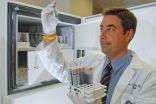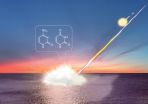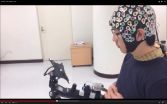(Press-News.org) BOSTON, Aug. 18, 2015 -- The use of solar energy in the U.S. is growing, but panels on rooftops are still a rare sight. They cost thousands of dollars, and homeowners don't recoup costs for years even in the sunniest or best-subsidized locales. But scientists may have a solution. They report today the development of a unique, "green" antenna that could potentially double the efficiencies of certain kinds of solar cells and make them more affordable.
The researchers are presenting their work at the 250th National Meeting & Exposition of the American Chemical Society (ACS). ACS, the world's largest scientific society, is holding the meeting here through Thursday. It features more than 9,000 presentations on a wide range of science topics.
"Most of the light from the sun is emitted over a very broad window of wavelengths," says Challa V. Kumar, Ph.D. "If you want to use solar energy to produce electric current, you want to harvest as much of that spectrum as possible."
But the silicon solar cells people buy today are not very efficient in the blue part of the light spectrum. So Kumar's team at the University of Connecticut built an antenna that collects those unused blue photons and then converts them to lower energy photons that the silicon can then turn into current.
"Many groups around the world are working hard to make this kind of antenna, and ours is the first of its kind in the whole world," he says.
Commercial solar cells do a good job of converting light from about 600 to 1,000 nanometers (nm) into electric current but not from the 350 to 600 nm range. That's part of the reason solar cells on the market today are only about 11 to 15 percent efficient. High-end panels can reach 25 percent efficiency but are unaffordable for most customers. Lab prototypes can reach even higher efficiencies but are difficult to scale up.
Converting the mostly unused portion of the light spectrum to wavelengths solar cells can use in an affordable way is far from a simple task. To tackle this problem, Kumar turned to organic dyes. Photons in light excite dye molecules, which can then, under the right circumstances, relax and emit less energetic but more silicon-friendly photons.
But to get dye molecules to work together, they need to be wrapped individually and densely, while satisfying certain quantum mechanical requirements. To address this issue, they embed the dyes inside a protein-lipid hydrogel by mixing them together, warming them up and then cooling them to room temperature. With this simple process, the material wraps around individual dye molecules, keeping them separated while packing them densely. Rather than creating a radio-like antenna, however, the procedure results in a thin, pinkish film that can be coated on top of a solar cell.
"It's very simple chemistry," Kumar says. "It can be done in the kitchen or in a remote village. That makes it inexpensive to produce."
These antennas are made with biological and non-toxic materials that are edible in theory, Kumar says. "Not that you would want to eat your solar cells, but they should be compostable so they won't accumulate in the environment," he says.
Now his team is working with a Connecticut company to figure out how to apply the artificial antenna to commercial solar cells. In other projects, they also are figuring out ways to use the versatile hydrogel for drug delivery and white light-emitting diodes.
INFORMATION:
A press conference on this topic will be held Tuesday, Aug. 18, at 11 a.m. Eastern time in the Boston Convention & Exhibition Center. Reporters may check-in at Room 153B in person, or watch live on YouTube http://bit.ly/ACSLiveBoston. To ask questions online, sign in with a Google account.
Kumar acknowledges funding from the University of Connecticut and the National Science Foundation.
The American Chemical Society is a nonprofit organization chartered by the U.S. Congress. With more than 158,000 members, ACS is the world's largest scientific society and a global leader in providing access to chemistry-related research through its multiple databases, peer-reviewed journals and scientific conferences. Its main offices are in Washington, D.C., and Columbus, Ohio.
To automatically receive news releases from the American Chemical Society, contact newsroom@acs.org.
Note to journalists: Please report that this research was presented at a meeting of the American Chemical Society.
Follow us: Twitter | Facebook
Title
Edible or digestible artificial light antennas: Hydrogels of dye-loaded bovine serum albumin and medium chain fatty acids
Abstract
With the goal of producing solar energy conversion devices that are environmentally friendly, green and sustainable, we are designing and evaluating artificial light antenna systems using biological soft materials. For example, well-controlled stoichiometric mixtures of four different dyes, bovine serum albumin and medium chain fatty acids form soft hydrogels when the mixtures are heated to 90 ?C for 8-10 minutes. These gels contain roughly 90% water and they are transparent to the eye when the dyes are absent. This is a robust and facile strategy to prepare biocompatible hydrogels composed of a protein, dyes and fatty acids which are digestible, in principle. The gelation was triggered by the weak physical interactions between partially unfolded protein and the fatty acid but unperturbed by the presence of added dye molecules or the type of dye molecules used. We postulate that the dyes are embedded in these hydrogels at discrete binding sites as monomeric entities and their concentrations are adjusted for efficient energy transfer from the highest energy donor to the lower energy acceptors. Thus, an energy transfer cascade system among four different singlet energy states are constructed, and excitation of any of the dyes results in intense emission from the lowest energy acceptor state. The transparent and mechanically strong hydrogels could be simply prepared by annealing their physical mixtures. The resulting hydrogels with a shear thin-recovery behavior were syringe-injectable for device or biomedical applications. These gels may also be suitable for implantable scaffolds for the long-term release of drug molecules in vivo, where the dyes are replaced by drug molecules, or they may function as light-harvesting complexes when loaded with appropriate donor and acceptor dye molecules.
INDIANAPOLIS -- People being treated for bipolar disorder and other psychiatric illnesses are at greater risk of attempting suicide, but physicians may now have tools to predict which of those individuals will attempt it and intervene early to prevent such tragedies from occurring.
Researchers at Indiana University School of Medicine reported Tuesday in the Nature Publishing Group's leading journal in psychiatry, Molecular Psychiatry, that they have developed blood tests and questionnaire instruments that can predict with more than 90 percent accuracy which of those patients ...
An unprecedented potential "molecular tweezer" called CLR01, reported in the journal eLife, not only blocks HIV and other sexually transmitted viruses, but also breaks up proteins in semen that boost infection.
Semen is the main vector for sexual HIV transmission. It contains proteins that assemble into very stable polymers called amyloid fibrils, which can enhance HIV infectivity by up to 10,000 times. Scientists led by the University of Pennsylvania (USA) and Ulm (Germany) now show that a molecule with the shape of a tweezer not only destroys HIV particles but also ...
A new study shown that meteorite impacts on ancient oceans may have created nucleobases and amino acids. Researchers from Tohoku University, National Institute for Materials Science and Hiroshima University discovered this after conducting impact experiments simulating a meteorite hitting an ancient ocean (Fig. 1).
With precise analysis of the products recovered after impacts, the team found the formation of nucleobases and amino acids from inorganic compounds. The research is reported this week in the journal Earth and Planetary Science Letters.
All the genetic information ...
Children with better academic and behavioral functioning when they start kindergarten often have better educational and societal opportunities as they grow up. For instance, children entering kindergarten with higher reading and math achievement are more likely to go to college, own homes, be married, and live in higher-income neighborhoods as adults. Now a new study points to very early roots of differences in school readiness, with growth in vocabulary playing a particularly important role. The study found that children with larger oral vocabularies by age 2 arrived at ...
Adolescents who have romantic relationships tend to have more problems with psychosocial adjustment. In contrast, young adults who have romantic relationships tend to have fewer problems with psychosocial adjustment. Although the links between having a romantic relationship and psychosocial adjustment change with age, a new longitudinal study has found that it's not just having a relationship that matters, but the quality of the relationship: Higher-quality romantic relationships are associated with fewer psychosocial difficulties across adolescence and young adulthood.
The ...
Scientists working at Korea University, Korea, and TU Berlin, Germany have developed a brain-computer control interface for a lower limb exoskeleton by decoding specific signals from within the user's brain.
Using an electroencephalogram (EEG) cap, the system allows users to move forwards, turn left and right, sit and stand simply by staring at one of five flickering light emitting diodes (LEDs).
The results are published today (Tuesday 18th August) in the Journal of Neural Engineering.
Each of the five LEDs flickers at a different frequency, and when the user focusses ...
A new test for offers the possibility of near real time monitoring of bone diseases, such as osteoporosis and multiple myeloma. The functionality of the test, which measures changes in calcium isotope ratios, has been validated on blood samples from NASA space shuttle astronauts.
Our bones are largely built of calcium, and the turnover of calcium can indicate the development of bone diseases such as osteoporosis and the cancer multiple myeloma. Geochemists have developed extremely accurate ways of measuring calcium isotope ratios, for example for the study of sea shell ...
For an embargoed PDF, please contact Cara Graeff or 215-351-2513 or Angela Collom or 215-351-2514.
1. Anonymous essay exposes scandalous doctor behavior
Free abstract: http://www.annals.org/article.aspx?doi=10.7326/M14-2168
Editorial: http://www.annals.org/article.aspx?doi=10.7326/M15-1144
URLs go live when embargo lifts
An anonymous and provocative essay published in Annals of Internal Medicine exposes the dark underbelly of medicine where doctors displayed stomach-churning disrespect for vulnerable patients. The author describes teaching a medical humanities ...
PHILADELPHIA - Websites for national and state health insurance marketplaces show evidence of improved efforts to assist patients in choosing health insurance plans, such as providing decision support tools, experts from the Perelman School of Medicine at the University of Pennsylvania have found. However, in a letter published in the August 18 issue the Annals of Internal Medicine, the Penn team recommends taking more steps to better support consumers in making informed health plan decisions.
The marketplaces, also called health exchanges, were established by the Patient ...
Research has shown that a regular dose of aspirin reduces the long-term risk of cancer in those who are overweight in an international study of people with a family history of the disease.
The study, conducted by researchers at Newcastle University and the University of Leeds, UK, is published today in the Journal of Clinical Oncology.
They found that being overweight more than doubles the risk of bowel cancer in people with Lynch Syndrome, an inherited genetic disorder which affects genes responsible for detecting and repairing damage in the DNA. Around half of these ...


